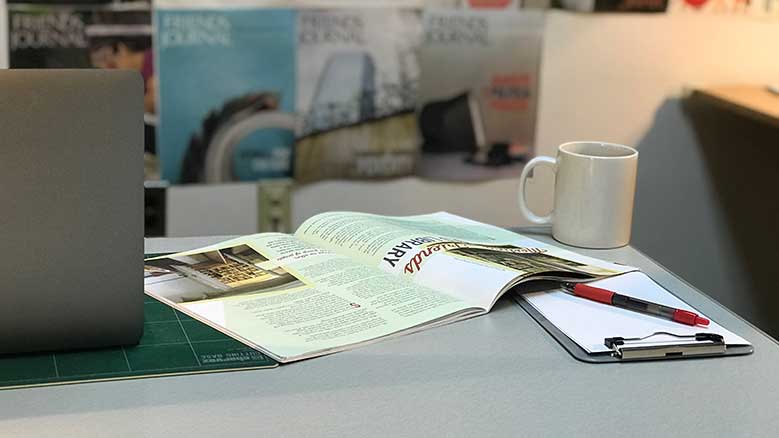Lessons from Joining a Meeting 400 Miles from Home
Isaiah is a homeless man in my neighborhood. He comes and goes at random. Lately, he’s been camped out on the street corner closest to my home. If he wanders off to another neighborhood for a while, neighbors will inquire as to whether he’s okay. Sometimes I’ve found him sleeping in my yard; sometimes I’ve found him defecating in my yard, which is more of a problem. Sometimes he is on drugs; sometimes he is very lucid. Sometimes I give him some money; sometimes I say, “Next time.” Sometimes he puts in a very specific special order when I’m on the way to the store: “Watermelon-flavored Arizona” was a recent request. Sometimes he smells terrible; sometimes he seems to have found a place to wash. Sometimes I’m happy to see him; sometimes I find myself bracing myself for the next request. But he always radiates an inner gentleness and kindness that makes him one of the easiest people in the world for me to discern that of God in a human being.
I start with these reflections on Isaiah because they humanize the issue of homelessness in a way that reveals a limitation of long-distance membership. I live in Long Beach, California, about 400 miles away from San Francisco (Calif.) Meeting, where I became a member in the fall of 2022. One of the current challenges to unity in our meeting is the rise of homeless encampments near the meeting. As I participate in discussions and listen to leadings in worship, I have to process very different ideas about what the meeting’s response should be. But since I participate in my meeting from a distance, these discussions remain abstract. I don’t have the full picture because I have no way to have real-life encounters like the ones I have with my neighbor, where the issue shifts from “homelessness” to “Isaiah.” In this sense, I see profound wisdom in the traditional practice of limiting membership to those who are geographically close to the meeting.

Still San Francisco Meeting has crossed into the territory of accepting members who worship at a distance. During the coronavirus lockdown, Zoom worship reconnected Friends who had moved away from the meeting and drew in people from various places. There wasn’t a deliberate choice to open membership to those at a distance. Rather, one person who had been participating in Zoom worship requested membership, and it was approved. I was the second person to request membership despite my living at a distance, and a member noted that the meeting had already opened the door to this new way of being a member. This decision will undoubtedly change the nature of the community in unforeseen ways. Some of those changes will strengthen the community; some of those changes will be challenges. Often major changes come about through subtle shifts that are hard to discern at the outset. Since it is far too early to see the implications of this decision for the meeting, I want to reflect mostly on how I approach my responsibilities to the community amidst the dizzying changes technology is bringing to our society.
A Friend asked me to reflect on this decision because I have a fairly unique relationship to participating via Zoom. I worshiped in person with San Francisco Meeting as an attender from 2005 to 2013. During that time, I served on and then clerked the Peace and Social Concerns Committee. When I moved away, I stopped attending meetings because I don’t have a car, and it would take too long to get to the other side of Los Angeles for one of the more local meetings. When the coronavirus pandemic hit, I started attending online worship with San Francisco Meeting. I was surprised, deeply surprised, by how Spirit-filled online worship could be. I found little difference in the depth of prayer facilitated by online vs. on-site worship. As pandemic restrictions eased, the meeting moved to a hybrid meeting. Some time after this, a Friend organized a Zoom discussion around the meaning of membership, which inspired me to seek membership.
Since then, I’ve taken a trip to San Francisco and visited the meeting in person, so I’ve had a reminder of what the differences are between online and in-person worship. One thing I’ve noticed is that I am significantly more attuned to worshipers who are gathered online when I am online and much more attuned to in-person worshipers when I’m worshiping in person. While this indicates a less-than-ideal situation for developing a deep sense of unity, I am grateful for the opportunity to have access to Quaker worship in a way that I had missed for several years. I am generally very averse to technology: I have managed to stave off getting a smartphone. But the way in which Zoom has allowed me to re-enter my Quaker community—and to enter it in a deeper way—has profoundly shifted my sense of the promise and perils of technological change in this context. While the limitations are apparent, the benefits are more so.
Perhaps long-distance membership is a way of extending the seeds of Spirit in a way that can transform more than a local community. As technology continues to transform the world we live in, we will continue to have opportunities to experiment, discern, and test the ways in which its transformations of community do and do not work.
One way that I have tried to minimize the gap between in-person and long-distance worship is to take on a project of sending handwritten letters to everyone in the meeting. (I haven’t done a good job of keeping track of to whom I’ve written and to whom I haven’t, so I’m not exactly sure of how far along I am.) Sometimes I hear back from people, either via letter or email. In some cases, people have responded by requesting Zoom meet-ups or phone calls, and I’ve had deep conversations with people I might only occasionally casually greet if I were there only in-person. So in these instances, the distance actually facilitated deeper connection. I have a hope that my letters give other people a deeper sense of belonging in the community, but for me, they definitely do.
I have also taken on the responsibility of serving on committees. Here the challenges of distant worship become more pronounced. I was first asked to serve on the Naming Committee, then the Nominating Committee, and finally asked to clerk the Welcoming Committee. I agreed to all of these requests. However, I declined a request to serve as clerk of the meeting because I felt that it was important for that position to be filled by someone who was in the area. Serving on the Naming and Nominating Committees poses particular challenges because there are members and regular attenders who have joined since I moved away. When other people name or nominate these people, I can’t always offer insight because I do not know them well. On the other hand, since I was so active in the meeting in the past, I have a deep connection with some of the more seasoned Friends and can understand some of the community dynamics very well. As clerk of the Welcoming Committee, I have to coordinate who opens the building for Sunday worship, and that is very much something for which I would prefer to be geographically close to the meeting, but it seems to be working out so far. So committee work is possible at a distance, but having a deep grounding in in-person worship certainly helps make it possible.
Will this experiment in long-distance membership prove fruitful? Does it further the aims of the Religious Society of Friends? Does technology offer a false promise, or is it an opportunity to discern Spirit in a new way? None of these questions are quite resolved in my mind. I feel the limitations of not having a regular physical sense of connection with the human beings who come to worship, but limitations are also a spur to creative responses. My weekly worship does strengthen my resolve to see that of God in everyone. It helps me bring that quest to my neighborhood: to approach my neighbor Isaiah with joy and to consider with equanimity the late-night motorcycle riders who’ve recently moved into the neighborhood. So perhaps long-distance membership is a way of extending the seeds of Spirit in a way that can transform more than a local community. As technology continues to transform the world we live in, we will continue to have opportunities to experiment, discern, and test the ways in which its transformations of community do and do not work.









Very inspiring article, distance meeting with technology to offer solution for worship.
Thank you for the inspirational insight of online worship being as surprisingly spirit-filled and deeply prayerful as in-person worship! No more distance/carbon emission excuses to avoid getting involved in a meeting. Any suggestions which meetings are best prepared for on-line members? Any online meetings focused on serving entire US or entire world?
I’d like to commune via zoom.